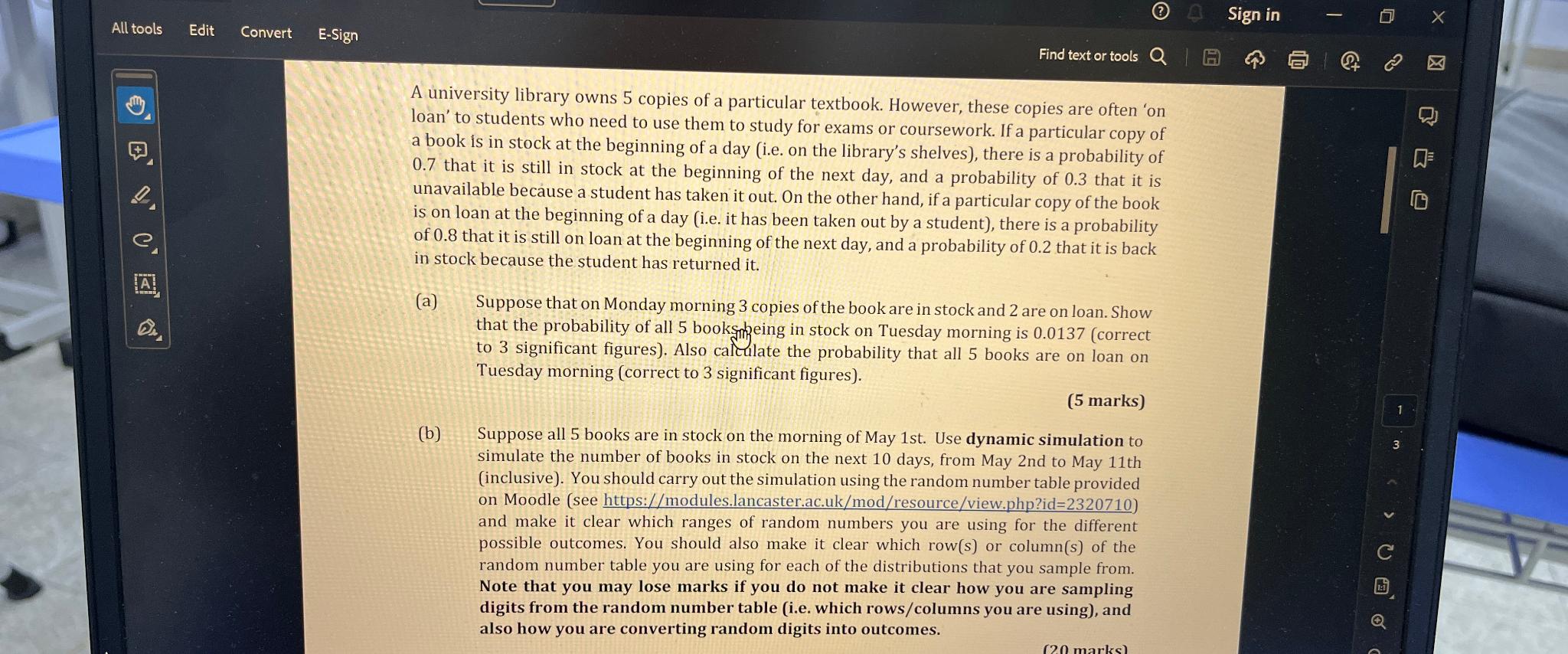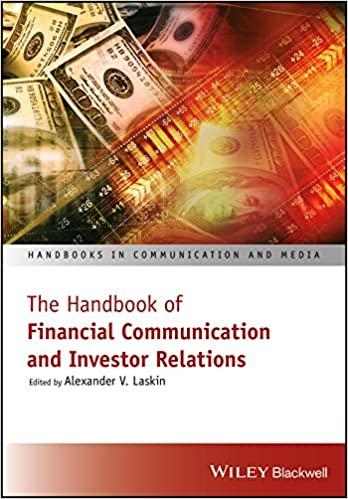All tools\ Edit\ Convert\ E-Sign\ Find text or tools\ A university library owns 5 copies of a particular textbook. However, these copies are often 'on loan' to students who need to use them to study for exams or coursework. If a particular copy of a book is in stock at the beginning of a day (i.e. on the library's shelves), there is a probability of 0.7 that it is still in stock at the beginning of the next day, and a probability of 0.3 that it is unavailable because a student has taken it out. On the other hand, if a particular copy of the book is on loan at the beginning of a day (i.e. it has been taken out by a student), there is a probability of 0.8 that it is still on loan at the beginning of the next day, and a probability of 0.2 that it is back in stock because the student has returned it.\ (a) Suppose that on Monday morning 3 copies of the book are in stock and 2 are on loan. Show that the probability of all 5 booksheing in stock on Tuesday morning is 0.0137 (correct to 3 significant figures). Also cafulate the probability that all 5 books are on loan on Tuesday morning (correct to 3 significant figures).\ (5 marks)\ (b) Suppose all 5 books are in stock on the morning of May 1st. Use dynamic simulation to simulate the number of books in stock on the next 10 days, from May 2nd to May 11th (inclusive). You should carry out the simulation using the random number table provided on Moodle (see \ https://modules.lancaster.ac.uk/mod/resource/view.php?id=2320710) and make it clear which ranges of random numbers you are using for the different possible outcomes. You should also make it clear which row(s) or column(s) of the random number table you are using for each of the distributions that you sample from. Note that you may lose marks if you do not make it clear how you are sampling digits from the random number table (i.e. which rows/columns you are using), and also how you are converting random digits into outcomes.

A university library owns 5 copies of a particular textbook. However, these copies are often 'on loan' to students who need to use them to study for exams or coursework. If a particular copy of a book is in stock at the beginning of a day (i.e. on the library's shelves), there is a probability of 0.7 that it is still in stock at the beginning of the next day, and a probability of 0.3 that it is unavailable because a student has taken it out. On the other hand, if a particular copy of the book is on loan at the beginning of a day (i.e. it has been taken out by a student), there is a probability of 0.8 that it is still on loan at the beginning of the next day, and a probability of 0.2 that it is back in stock because the student has returned it. (a) Suppose that on Monday morning 3 copies of the book are in stock and 2 are on loan. Show that the probability of all 5 booksintheing in stock on Tuesday morning is 0.0137 (correct to 3 significant figures). Also calculate the probability that all 5 books are on loan on Tuesday morning (correct to 3 significant figures). (5 marks) (b) Suppose all 5 books are in stock on the morning of May 1st. Use dynamic simulation to simulate the number of books in stock on the next 10 days, from May 2nd to May 11th (inclusive). You should carry out the simulation using the random number table provided on Moodle (see https://modules.lancaster.ac.uk/mod/resource/view.php?id=2320710) and make it clear which ranges of random numbers you are using for the different possible outcomes. You should also make it clear which row(s) or column(s) of the random number table you are using for each of the distributions that you sample from. Note that you may lose marks if you do not make it clear how you are sampling digits from the random number table (i.e. which rows/columns you are using), and also how you are converting random digits into outcomes. A university library owns 5 copies of a particular textbook. However, these copies are often 'on loan' to students who need to use them to study for exams or coursework. If a particular copy of a book is in stock at the beginning of a day (i.e. on the library's shelves), there is a probability of 0.7 that it is still in stock at the beginning of the next day, and a probability of 0.3 that it is unavailable because a student has taken it out. On the other hand, if a particular copy of the book is on loan at the beginning of a day (i.e. it has been taken out by a student), there is a probability of 0.8 that it is still on loan at the beginning of the next day, and a probability of 0.2 that it is back in stock because the student has returned it. (a) Suppose that on Monday morning 3 copies of the book are in stock and 2 are on loan. Show that the probability of all 5 booksintheing in stock on Tuesday morning is 0.0137 (correct to 3 significant figures). Also calculate the probability that all 5 books are on loan on Tuesday morning (correct to 3 significant figures). (5 marks) (b) Suppose all 5 books are in stock on the morning of May 1st. Use dynamic simulation to simulate the number of books in stock on the next 10 days, from May 2nd to May 11th (inclusive). You should carry out the simulation using the random number table provided on Moodle (see https://modules.lancaster.ac.uk/mod/resource/view.php?id=2320710) and make it clear which ranges of random numbers you are using for the different possible outcomes. You should also make it clear which row(s) or column(s) of the random number table you are using for each of the distributions that you sample from. Note that you may lose marks if you do not make it clear how you are sampling digits from the random number table (i.e. which rows/columns you are using), and also how you are converting random digits into outcomes







